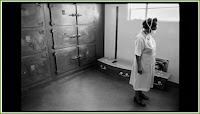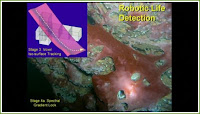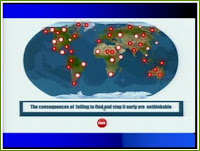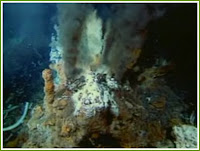The March issue of International Microbiology included a very nice article by Roberto Kolter, professor of Microbiology and Molecular Genetics at Harvard Medical School. The title is Biofilms in lab and nature: a molecular geneticist’s voyage to microbial ecology (freely available as PDF).
In the article, the author gives an entertaining account of the path that lead him to the study of biofilms -- that is, aggregations of microbes growing on solid substrates. He also highlights some of his recent research on the ecology of microbial islands.
There is also a fish tank anecdote. And I added a couple of microbial cartoons, just for fun!

Microbes are excellent model organisms... at least for studies on basic cellular processes. As Jacques Monod put it: Ce qui est vrai pour le colibacille est vrai pour l’éléphant ("what is true for the colibacillus is true for the elephant"). That is why Roberto Kolter (and many other researchers) soon fell under the spell of bacteria and, in particular, the colibacillus Escherichia coli.
For some time, Kolter studied the regulation of cell growth in E. coli. Under the right conditions, cells divide to yield daughter cells, which grow and divide quickly again, and so on -- and the bacterial population undergoes exponential growth. This exponential phase of growth (a.k.a. log phase) is typically followed by a stationary phase, when the growth rate slows down due to a scarcity of nutrients and accumulation of toxic products. Eventually, the bacterial population shrinks, in what is known as death phase (you can visit Cells alive! or Wikipedia for basic information on bacterial growth).
These processes are typically studied in the laboratory using shaken cultures. The shaking of flasks and test tubes keeps the broth composition uniform throughout the flask, and provides a continuous supply of fresh air that helps microbes grow fast. As a result, the cells are in a planktonic state; that is, they grow in suspension in the broth.
 From these shaker-sick cultures, Kolter and coworkers learnt a few interesting things about what happens during the stationary and death phases. In the International Microbiology article, he summarizes their findings as follows:
From these shaker-sick cultures, Kolter and coworkers learnt a few interesting things about what happens during the stationary and death phases. In the International Microbiology article, he summarizes their findings as follows: "And what we found through genetic analyses was rather extraordinary. Death allowed new life; we were witnessing evolution in real time [...]. Underlying the usually observed death phase was a dynamic world of dying and growing bacteria. There were constant population takeovers such that pre-existing fitter bacterial mutants grew as the original population met its demise. Evolutionary cheating we would call it later on [...]"
In other words, the adverse conditions occurring in the E. coli cultures during the death phase (toxic products, little food) appeared to have two contrasting effects. It was obvious that many cells were dying -- but, at the same time, successive waves of different spontaneous mutants were able to thrive and outgrow their dying siblings in this less-than-optimal environment. These findings were reviewed in two papers with memorable titles: Life after log and GASPing for life in stationary phase.
Isn't that a fascinating microcosms? The little creatures in the test tube were not just dying; they were evolving!

And now, the fish tank anecdote. Or, in Kolter's own words, the epiphany of the fish tank: "The years that followed represented for me a dramatic turn of direction in my research. One might ascribe the change to some sort of “post-tenure depression”; I refer to it as the “epiphany of the fish tank” now. [...]
Microbial life on surfaces, for decades studied by Bill Costerton and other intrepid pioneers of the biofilm field, had been long ignored by most microbial physiologists and molecular geneticists, myself included. However, things changed for me in 1994 when, noticing my depressed state, members of my laboratory gave me a fish tank in a effort to draw me out of the blues. As I sat locked-up in the office staring at the tank, I realized that by studying shaken cultures of E. coli I had been barking up the wrong tree. The water in the fish tank remained crystal clear, it was on the surfaces where most microbial activity was occurring."
 That observation applies well beyond fish tanks. It is possible that the majority of microbes on Earth spend most of their lives in aggregates attached to surfaces, and therefore not in a free-floating or swimming, planktonic state. Obviously, they are not solitary guys: we could view biofilms in nature as quite complex 'societies' or 'cities' where different types of microorganisms inhabit buildings made out of sticky macromolecules (polysaccharides, proteins, DNA). Importantly, microbes in biofilms are sometimes resistant to the action of antibiotics, to which the same organisms are sensitive when in planktonic state.
That observation applies well beyond fish tanks. It is possible that the majority of microbes on Earth spend most of their lives in aggregates attached to surfaces, and therefore not in a free-floating or swimming, planktonic state. Obviously, they are not solitary guys: we could view biofilms in nature as quite complex 'societies' or 'cities' where different types of microorganisms inhabit buildings made out of sticky macromolecules (polysaccharides, proteins, DNA). Importantly, microbes in biofilms are sometimes resistant to the action of antibiotics, to which the same organisms are sensitive when in planktonic state.
So, have microbiologists been "barking up the wrong tree" all this time? Well, not exactly. Experiments using shaken cultures have been, and will continue to be, extremely useful. They are, without doubt, highly valuable to learn about the biochemistry, genetics and many other aspects of the biology of microbes. And they have been instrumental in providing us with antibiotics and vaccines to fight infectious disease.
But it is true that shaken cultures are sometimes not the best research models, especially if we try to understand 'the real life' of a microbe in its natural environment.
 The 'fish tank epiphany' lead Kolter into biofilm research. A first approach he and his collaborators took was to study the biofilms formed by certain Bacillus subtilis strain. The accompanying image shows --on the left-- a beaker with a floating film that the microbe forms when grown in a standing (not shaken!) liquid culture, and --on the right-- a magnified view of a colony grown on an agar plate. Although these biofilms consist only of a single organism, they are actually highly structured, with several layers composed of different cell types engaged in various activities: some cells are actively producing the matrix (not the Wachowskis' movie but the glue that keeps the biofilm together), others are swimming around, and there are also some cells in the process of becoming spores. How close is that to a multicellular organism?
The 'fish tank epiphany' lead Kolter into biofilm research. A first approach he and his collaborators took was to study the biofilms formed by certain Bacillus subtilis strain. The accompanying image shows --on the left-- a beaker with a floating film that the microbe forms when grown in a standing (not shaken!) liquid culture, and --on the right-- a magnified view of a colony grown on an agar plate. Although these biofilms consist only of a single organism, they are actually highly structured, with several layers composed of different cell types engaged in various activities: some cells are actively producing the matrix (not the Wachowskis' movie but the glue that keeps the biofilm together), others are swimming around, and there are also some cells in the process of becoming spores. How close is that to a multicellular organism?
The B. subtilis biofilm is a very useful model -- but you may well think that a beaker containing a single microbial species is a very artificial setting.
Then, how can scientists study biofilms in natural environments? For Kolter, the inspiration came -- no fish tank involved -- from the writings of biologist E. O. Wilson. In collaboration with Robert MacArthur, Wilson developed in the 1960s the theory of island biogeography, which has become fundamental in ecology and evolutionary biology. The theory tries to explain the factors that control the number of species in a natural community (it was originally developed for islands but now it is applied to any ecosystem that is surrounded by other ecosystems). Kolter was fascinated by the ways Wilson studied newly formed islands to put the theory to the test (what Wilson actually did was to fumigate some small islands to kill all arthropods, and then observe how the islands were recolonized). However, Kolter was wise enough and did not try to make free from microbes any islands (that would be tough!). His approach, much less destructive, consisted of studying two natural microbial islands: the pitchers of a carnivorous plant, and the human lungs.
 The first island is Sarracenia purpurea, a carnivorous plant feeding on the insects and spiders that fall into its water-filled pitchers. Kolter and collaborators found that the inside of unopened, newly formed pitchers was sterile -- there you go, a microbial island is born! This allowed them to analyse the composition of the nascent bacterial population in the pitchers during the season, as microbes colonized the island. Among other results, the researchers found that pitchers containing certain mosquito larvae (keystone predators) had a greater bacterial diversity.
The first island is Sarracenia purpurea, a carnivorous plant feeding on the insects and spiders that fall into its water-filled pitchers. Kolter and collaborators found that the inside of unopened, newly formed pitchers was sterile -- there you go, a microbial island is born! This allowed them to analyse the composition of the nascent bacterial population in the pitchers during the season, as microbes colonized the island. Among other results, the researchers found that pitchers containing certain mosquito larvae (keystone predators) had a greater bacterial diversity.
The second microbial island studied by Kolter and coworkers is the respiratory tract of humans suffering from cystic fibrosis (CF). As long as you are healthy, your lungs are supposed to be mostly sterile. However, respiratory diseases such as CF or asthma open the gates to outside microbial colonizers, which can make a lot of harm. In CF, the major microbial pathogen is the bacterium Pseudomonas aeruginosa, which forms biofilms inside the lungs and can easily become resistant to antibiotics. Using culture-independent methods, Kolter's laboratory compared the microbial communities in the lungs of different CF patients. The researchers showed that the presence of P. aeruginosa was correlated with lower microbial diversity, worse lung function, and patient age. In other words, it appears that the arrival of P. aeruginosa (an 'invasive species') greatly affects the microbial community in CF lungs, resulting in a decrease in diversity. The researchers suggest that the composition of the microbial community could be a better predictor of disease progression than the presence of P. aeruginosa alone.
Well, that was a long post. Please read Roberto Kolter's article (it is free), which includes a few more interesting thoughts and quotes. The concept of microbial islands is fascinating. And the growing interaction between the long-time isolated fields of ecology and microbiology is, I think, changing the way microbiologists view their study subjects. Hopefully, ecologists will also become more aware of the organisms that rule the planet -- which are not humans, you know.
Reference for Roberto Kolter's article:
Roberto Kolter (2010). Biofilms in lab and nature: a molecular geneticist’s voyage to microbial ecology. Int. Microbiol., 13, 1-7. DOI: 10.2436/20.1501.01.105 (pdf)
Related links:
- Biology of microbial communities - Interview to Roberto Kolter (video). JoVE, May 2007.
- Roberto Kolter - Bacillus subtilis and bacteria as multicellular organisms (podcast). Meet the Scientist, episode 20, March 2009. MicrobeWorld.
- The evolution of the biofilm concept: a long and winding road (free PDF), by J.W. Costerton. Sartoniana (2008) 21:59-67.
- About the existence of microbes (viruses) in healthy and diseased human lungs: Metagenomic Analysis of Respiratory Tract DNA Viral Communities in Cystic Fibrosis and Non-Cystic Fibrosis Individuals (2009). PLoS ONE 4(10): e7370. doi:10.1371/journal.pone.0007370 (free article).
Image credits:
- Cartoons by Sanja Saftic. Many thanks to her for allowing me to use the cartoons for this blog post. Source: Biotoon.com - Microbiological Edutainment.
- Color-enhanced scanning electron microscope (SEM) image of a biofilm formed by Desulfovibrio desulfuricans bacteria. Image by PNNL - Pacific Northwest National Laboratory. Source: Flickr.
- Beaker and colony: highly structured biofilms formed by Bacillus subtilis strain NCIB 3610. Source: International Microbiology.
- Sketch of carnivorous plant: Sarracenia purpurea. Source: Wikimedia Commons.
Read the rest of the article >>>





























































